Sat 5 May 2012
Reviewed by Walker Martin: DAVID GOODIS – Five Noir Novels of the 1940’s and 1950’s.
Posted by Steve under Authors , Bibliographies, Lists & Checklists , Pulp Fiction , Reviews[39] Comments
DAVID GOODIS – Five Noir Novels of the 1940’s and 1950’s. Library of America, hardcover, March 2012.
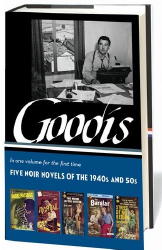
I’ve been reading and collecting books from The Library of America ever since they first started coming out. At first it looked like they would just be publishing the works of the established literary figures, great authors like Henry James, Eugene O’Neill, Mark Twain, Herman Melville, and so on.
But lately they have crossed over into more popular areas and genres by publishing two volumes of crime novels (including Down There by David Goodis), Dashiell Hammett, Raymond Chandler, H.P. Lovecraft, Philip K. Dick, Edgar Rice Burroughs, Kurt Vonnegut, two volumes titled American Fantastic Tales, and now David Goodis.
I see this as a very good sign for popular culture and the mystery and SF genres. I guess it is too much to hope for volumes dealing with great western fiction but seeing this volume on Goodis makes me hope that we will see collections by Jim Thompson, Peter Rabe, Charles Williams, John D. Macdonald, Ross Macdonald, Gil Brewer, and others.
We should not be surprised to see Goodis singled out for such attention because the French have long thought he was exceptional and in fact the only full length biography is in French. He was the poet of the bleak, doomed, and lost. It’s been said that Goodis did not write novels; he wrote suicide notes.
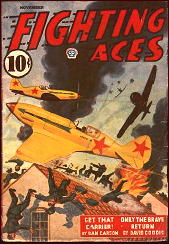
I first became aware of David Goodis back in the 1960’s when I started to collect the pulp magazines. His pulp career lasted from 1939 to about 1947. He has been quoted as saying that he produced millions of words for the sport, detective, and western pulps. But most of his work was published in what I call the air-war pulps. I eventually accumulated extensive runs of such titles as Fighting Aces, Battle Birds, RAF Wings, Dare-Devil Aces, and Sky Raiders. Goodis appeared in all these pulps with dozens of stories, perhaps over a hundred.
I would have to admit that I found his pulp work to be less than interesting. I’ve always had a problem with the air pulps with seemed to concentrate too much on airplanes and flying, while ignoring characterization and believable plots. I eventually sold, traded, and disposed of all my air-war magazines.
There is an excellent DVD dealing with Goodis’ life, marriage, and career called David Goodis … to a Pulp It’s a must for anyone interested in his writing and one of the extras points out that Goodis’ wife evidently felt the same way as I did concerning his pulp stories.
His wife told her second husband that the reason she left Goodis and divorced him was because she couldn’t stand his pulp writing that he was doing for the air-war magazines.
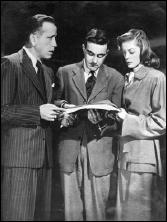
She must have received a shock when he broke into the slick market with his novel, Dark Passage for the Saturday Evening Post in 1946. Not only did he receive a far higher rate of pay than he was getting for his pulp work, but Hollywood paid $25,000 for the screen rights. In today’s money that is around a quarter of a million. The movie was not just your usual effort, but starred Humphrey Bogart and Lauren Bacall.
At this time it was goodbye to the pulps and the beginning of his Hollywood career. Despite receiving good money he still wore threadbare suits and slept on the couch of a friend for $4.00 a month. He soon found himself out of a job and back in Philadelphia, living in his parents house, and writing original novels for such paperback firms as Gold Medal.
The Library of America edition reprints five complete novels. All five were made into interesting movies. and my comments on both the books and films follow:
â— Dark Passage. Though this is Goodis’ first real success, I don’t think it is an outstanding novel. My feeling on a second reading was that it is OK, good in spots by nothing that special.
The story is not too believable and suffers from the happy ending. It reminds me of Cornell Woolrich, only not as good. I find the plot absurd with the rich, pretty girl falling in love with the loser convicted of murder. Also ridiculous to think that a cab driver and doctor would help the hero without even knowing anything about him.
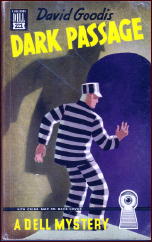
I watched the movie for the sixth time (I have a Bogart book which I annotate every time I see one of his films), and it’s hard to believe that they would cover up his face in bandages for most of the movie. But it does follow the plot of the novel and I find it better than the book.
â— Nightfall. This also is just OK but nothing that special. Another innocent man framed for murder and robbery. Both these novels have a silly scene where the hero gets the gun away from the criminal by distracting him with talk. And another beautiful girl.
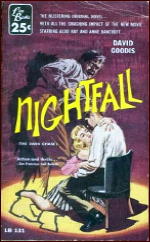
Again I found the movie better than the book. It follows the basic plot with some changes but Aldo Ray is bland as the innocent man in trouble. Great villain.
â— The Burglar. I found this novel to be better than the two above. Instead of the typical innocent man wrongly accused plots, this one was more believable with a professional jewel thief becoming involved in killings. Very downbeat ending, just what you would expect from Goodis.
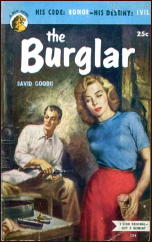
The movie stars Dan Duryea and Jayne Mansfield and follows the plot of the novel. The fact that David Goodis wrote the screenplay makes this even more interesting.
â— The Moon in the Gutter. With this book, it appears the novels are getting better. This one does not star a criminal or men framed for murder but has as a protagonist a laborer working on the docks and living in a slum area of Philly.
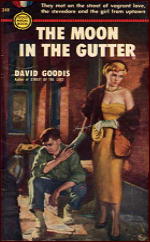
He hangs out in a dive called Dugan’s Den, which has the atmosphere and characters right out of a Eugene O’Neill play. Vernon Street in Philadelphia takes on a life of its own and becomes a character in the novel.
The movie was made in 1983 and is French with subtitles, starring Gerard Depardieu and Nastassia Kinski. It follows the basic plot of the novel.
â— Street of No Return. Mediocre and not too believable. Skid row bum and drunk (a former famous singer) defeats criminal plan to cause race riots. Dialog is poor and the police act like idiots. Another beautiful girl falls for our hero.
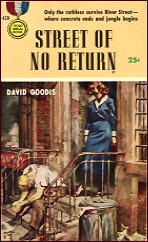
The movie was directed by Samuel Fuller and stars Keith Carradine. However in this case, the film was even more disappointing than the novel. Believe me, you don’t want to see Keith Carradine in a fright wig, trying to act like a bum.
Despite the critical comments above, I did enjoy reading the five novels but lucky for me after reading them I immediately spent some time at a book convention buying and reading pulps. Otherwise, I might have hanged myself. No wonder Goodis lived such a short life, from 1917 to 1967.
Bibliography (novels and story collections only)
Retreat from Oblivion, 1939.
Dark Passage, 1946.
Nightfall, 1947.
Behold This Woman, 1947.
Of Missing Persons, 1950.
Cassidy’s Girl, 1951.
Of Tender Sin, 1952.
Street of the Lost, 1952.
The Burglar, 1953.
The Moon in the Gutter, 1953.
Black Friday, 1954.
Street of No Return, 1954.
The Blonde on the Street Corner, 1954.
The Wounded and the Slain, 1955.
Down There (Shoot the Piano Player), 1956.
Fire in the Flesh, 1957.
Night Squad, 1961.
Somebody’s Done For, 1967.
Black Friday and Selected Stories, 2006. [A collection of his shorter work from such magazines as Ten Story Mystery, Colliers, New Detective, Manhunt and Mike Shayne Mystery Magazine.]
May 5th, 2012 at 10:35 pm
Apparently, Jack Warner was disappointed with the film and especially covering Bogart’s face for more than half the picture. I think Dark Passage of interest, but both you and Jack were onto something.
May 5th, 2012 at 10:49 pm
Humphrey Bogart is a big favorite and I’ve watched some of his movies so many times. Everytime I view DARK PASSAGE I’m puzzled as to why they chose Bogart who was probably the biggest and highest paid star of the time, to star in the movie. His face is covered up for the first 62 minutes of the 90 minute film.
May 6th, 2012 at 10:23 am
The only Goodis novel I’ve read is NIGHTFALL. It seemed mediocre, unimaginative and routine.
I confess I’m baffled by the huge enthusiasm shown by many people for non-mystery, noir-ish “crime fiction”. Just don’t get why books like NIGHTFALL or Jim Thompson’s THE KILLER INSIDE ME are admired.
Compared to literary mainstream novels like Melville’s MOBY-DICK, Bronte’s JANE EYRE, Crane’s THE RED BADGE OF COURAGE, they seem really tenth rate.
And they don’t have the plotting skills shown in detective stories like those by Ellery Queen, Helen McCloy, or John Dickson Carr. Or the imaginative “strangeness” that often engulfs their commendably bizarre tales. Instead, Goodis and his characters seem conformist and conventional.
May 6th, 2012 at 11:30 am
Bogart was the perfect choice in the movie. As he would show in the radio series BOLD VENTURE, Bogart had a rare talent of being a great physical actor and a great voice actor. Few box office stars could have succeed in a film with their face hidden for such a great part of the film.
May 6th, 2012 at 11:41 am
Mike Grost comments above provide plenty of topics for discussion. First of all I have to admit that after reading the 5 Goodis novels I really wondered if I should submit a review to MYSTERY FILE. I usually like to discuss books that are outstanding and very impressive. If I started reviewing mediocre novels, I would bury myself in negative comments which I don’t want to do.
However, this collection has created quite a buzz on the internet and I felt I should still discuss Goodis even though I had problems with his pulp work and novels. I did enjoy reading the novels but I thought only 2 of the 5 were good: THE BURGLAR and MOON IN THE GUTTER. The other 3 simply had too many scenes that rang false.
But, I don’t want to give the opinion that I feel this way about all the “noirish” crime fiction. I do like some of Jim Thompson, Peter Rabe, Charles Williams, Gil Brewer, etc.
I have read all three of the literary novels that Mike mentions: MOBY DICK, I’ve read 3 times and think is in the running for best American novel, THE RED BADGE OF COURAGE, I love because of my big interest in the Civil War, and JANE EYRE is a classic. But great novels like these are in another world and the vast majority of novels cannot compare to them.
I agree that Mike’s last sentence has some validity, “…his characters seem conformist and conventional”. But the big thing about Goodis is the noirish, downbeat, atmosphere of impending doom. This drives his novels and I guess is the main element why so many readers admire him and why The Library of America included him in their series.
May 6th, 2012 at 11:42 am
Why does the Library of Congress edition suddenly declare Goodis a quality writer? Aren’t these editions more interested in illustrating forms of literature? Isn’t the goal to reflect pop culture of the period by showing what people were reading and still are reading?
To compare noir novels and traditional mysteries serves a purpose only to help the reader decide which he or she would prefer reading. Every genre and sub-genre has its own set of rules.
I don’t dislike Ellery Queen because of their weak characterization, because that is not the point of traditional mysteries. I can see why fans of the genre admire him without liking him or the genre.
Goodis and Thompson, I see both talents without ever wanting to suffer through another of their work again.
May 6th, 2012 at 11:51 am
I agree with Michael about Bogart being a great physical actor and a great voice actor. If I had to pick my all time favorite movie actor, Bogart would certainly be in the running for first place.
But Bogart also had a face that movie goers love and they wanted to see it. Instead we get another camera point of view like LADY IN THE LAKE. Now frankly I do like both movies but I can see why critics and viewers complain about DARK PASSAGE and LADY IN THE LAKE.
May 6th, 2012 at 12:14 pm
I see a lot of discussion has already taken place before I was able to get to the computer this afternoon. It’s not surprising, since David Goodis is one of those authors that seem to stir up a lot of commentary, both pro and con.
I have to confess that I have not read any of his books since the 1960s, and probably not all of them, even then. So it’s difficult to say very much, and I probably shouldn’t even try.
But I will anyway. You can take Ellery Queen as an example of one side of the crime fiction spectrum, and David Goodis as the other — EQ representing the upbeat puzzle-oriented story (upbeat because evil is found out, the case is solved, justice prevails), and Goodis standing in for downbeat tales which seldom end happily for anyone, including (and maybe especially) the protagonist.
I was probably split 50-50 between the two when I was younger, but over the years my tastes have tended to move over to the EQ side. I don’t know if that’s a common trend or not, but it’s been true for me.
As for David Goodis, I think most critics will agree that his writing can often be dull and far too expository, and yet: it is the bleakness of his stories that appeals to many of his devoted fans, overriding whatever faults he may have.
I prefer Cornell Woolrich myself, and some of the other authors that Walker names, Gil Brewer, Charles Williams and so on. But Goodis has somehow caught the fancy of a lot more readers than either of the latter two — a phenomenon not restricted to the US only, and one that’s certainly worth noting and talking about.
May 6th, 2012 at 12:19 pm
Michael, in Comment #4. Once again you display the knack of turning “conventional wisdom” around and showing another way of looking at something. I’ve always thought of Bogart’s bandaged face in DARK PASSAGE silly, to coin a phrase, but I’ve also always enjoyed the movie, every time I’ve seen it.
You’ve explained how that might be so — how those two basically contradictory reactions could be reconciled.
May 6th, 2012 at 12:24 pm
Michael in Comment #6 made me start thinking what is the purpose of The Library of America? I went to their website and under the topic History and Mission I found the following statement:
“The Library of America was founded in 1979 to undertake a historic endeavor: to help preserve the nation’s cultural heritage by publishing American’s best and most significant writing in durable and authoritative editions.”
I was one of the early subscribers to the series, which now numbers over 200 volumes, and to tell the truth, never in my wildest dreams did I ever think that I would see volumes devoted to Philip K. Dick, Lovecraft, or Goodis. As the volumes came out it was obvious that they planned on publishing the great American writers, those that were literary with a capital L.
But somewhere along the way they started to notice some outstanding writers in the so called genre fiction area. Certainly Hammett and Chandler have been accepted into mainstream literature but the 2 volume set on crime novels was a major surprise. Then along came Lovecraft, Philip K. Dick and now Goodis. Even Edgar Rice Burroughs has appeared in 2 books, though not in the standard edition used for all the other volumes.
As I said above, this can only be a very good sign that mainstream literary critics and scholars are more and more ready to realize that there are outstanding and great SF novels, crime novels, horror fiction, etc.
We may argue about Goodis and whether he deserves to be included but this volume is a great step forward as far as I’m concerned and that’s why I felt I had to bring it to the attention of MYSTERY FILE for discussion.
May 6th, 2012 at 12:34 pm
On the other side of the spectrum I was talking about, Walker or anyone, do you think there is a chance that LoA will publish a volume of early Ellery Queen novels? Or if not, is there another practitioner of pure detective puzzles that they might (or should) consider?
May 6th, 2012 at 1:02 pm
Steve, in Comment #11 poses a fascinating question about the possibility of LoA publishing a collection of pure detective puzzles. I really do not see this happening because of the emphasis on the puzzle aspect. Usually this is at the expense of such literary necessities as great characterization and literary style.
I’m hoping for a Ross Macdonald, Charles Williams, Gil Brewer, etc collection, but really the odds are not good. Maybe Ross Macdonald since he received alot of literary attention back in the 1970’s. In SF, I think they could do a nice 2 volume collection containing some classic novels. I personally think Robert Silverberg deserves a volume from his late 1960’s through early 1970’s period when he wrote some great novels mainly for GALAXY.
Even a 2 volume set on great westerns would be nice. But I don’t see a volume on the puzzle detective novels.
May 6th, 2012 at 1:34 pm
The most likely challenge to reading a Library of America collection of traditional mysteries is the perception of the sub-genre is a reflection of British culture more than American.
Few genres are perceived more American than hardboiled mystery and noir.
Again I think they are looking more for important than great. Today when you think of traditional it is Doyle and Christie that come to mind.
I’d expect a Western fiction collection before traditional mysteries.
May 6th, 2012 at 2:28 pm
The reason I chose Ellery Queen to represent the traditional detective story is the same as Anthony Boucher’s, who is reported as having said, “Ellery Queen is THE American detective story.” But times and tastes have changed, and Michael you are quite right. Hardboiled mysteries and noir are very much in favor now.
And I’m inclined to agree with both you and Walker. The chances of a LoA collection of EQ novels are rather slim. But perhaps a collection of his (their) short stories? Or a collection of traditional detective stories from various authors? It would not be hard to do, and it would be nice to see.
As for a collection of western novels and short stories, I’d love to see that, too! Even though the genre is gasping for air right now, what’s more American than the western story?
May 6th, 2012 at 3:14 pm
#14. The Library of America is not looking for popular or to get on the best seller list. That is one of the reasons they can do a book of Goodis novels. I also don’t see the Goodis release to change the public’s interest in him.
I get the weekly free Library of America download story. The choices range all over fiction and non-fiction leaning to critically, culturally, and historically significant.
They are to books what PBS should be but isn’t to TV.
May 6th, 2012 at 3:19 pm
By the way, I really enjoyed the review.
And learned from it and the discussion.
Have never read any Peter Rabe. Maybe he should be next.
I’d buy a Merle Constiner LOA in an instant!
May 6th, 2012 at 3:36 pm
I second Mike Grost’s suggestion about a Merle Constiner collection. I’ve been recommending Constiner for 40 years now especially his Dean series from DIME DETECTIVE and the Luther McGavock series from BLACK MASK. I was speaking to George Vanderberg the head guy behind Battered Silicon Dispatch Box and he said that another collection of Merle Constiner stories will be out this year. He already has published THE COMPLEAT DEAN, 19 long novelets about the crazy Dean character.
Steve is right. What is more American than the western? There are great western novels though one of the greatest, LONESOME DOVE is too long.
May 6th, 2012 at 4:49 pm
At the moment, I’m reading Peter Rabe’s ‘Get that Man’, my second, and I’m enjoying myself greatly.
Anything that preserves the old masters for us everyday readers, who are NOT collecting , is a good thing.
Don’t get me wrong, my hat is off to the collectors, and they play a very important part in the preservation of good books in general, but few are willing to invest the time and money, sometimes GREAT sums,and thus reprints at affordable prices are so important.
These also enhance the value of the collection, as the number of people who know the names of old author increases, as does the market for originals.
The Doc
May 6th, 2012 at 5:14 pm
The Doc is right on both points. Peter Rabe is outstanding and I’ve read many of his original Gold Medal paperback novels. He has been reprinted recently by Stark House.
He also is right on target about this being the Golden Age of Reprints. I have several reprint volumes lined up for possible review, so many that I many not be able to keep up with the volume.
Look at the major collections just published in the last couple months: three by Frederick Nebel, one by Paul Cain, and now the David Goodis volume.
One thing puzzles me however, where are the Goodis 100% supporters? I know they are out there. There is even a convention in his honor in Philadelphia. I’d like to hear from someone who disagrees with the above comments criticizing Goodis.
May 6th, 2012 at 6:55 pm
I just noticed that Geoffrey O’Brien has been editor in chief of the Library of America since 1998. This explains why we have volumes on Goodis, noirish crime novels and Philip K. Dick, among others.
O’Brien wrote the book, HARDBOILED AMERICA: LURID PAPERBACKS AND THE MASTERS OF NOIR.
May 6th, 2012 at 8:57 pm
I didn’t know that, and it says a lot, doesn’t it? I don’t know about anyone else, but I think it’s great that someone like O’Brien is in charge.
May 6th, 2012 at 10:10 pm
OK Walker,
I’m one of the 100% you’re looking for. I do agree with you about Goodis’s pulp work. I don’t care about the aviation stories at all. Never did, but I have read all his detective story appearances and haven’t found them to be anything but ordinary. Very surprising to me. As far as his novels go, no one writes a more consistently down beat story than him. I’d go so far as to say that overall he’s better than Thompson. His best book hands down is “Black Friday”. Starts out bad and gets progressively worse for the main character. Why do I like Goodis so much? Probably for the same reason I like film noir. I’m always rooting for the underdog knowing it’s still going to turn out bad in the end.
May 6th, 2012 at 10:25 pm
I’m glad you commented Paul, because I know there are alot of readers who like Goodis and they should be represented on this post.
On the LoA website Geoffrey O’Brien and another editor both pick THE BURGLAR as the best of the five novels in the collection.
Though I did have some problems with this collection, I wanted to read Goodis for the same reason you mention, I love film noir.
May 7th, 2012 at 1:11 am
Goodis’ novels seem to be silly only from a realistic point of view but they function more like a bad dream, a nightmare. “Cassidy’s Girl” which is not in the edition is for me one of the better novels about the tragic consequences of alcohol abuse.
May 7th, 2012 at 5:57 am
Another reason for leaving Bogart’s face bandaged for so long was to ease the audience into accepting his aged appearance opposite Bacall.The surgeon even makes a remark about how his new face will make him look older.And even tho they made another movie together,it wasn’t as a romantic couple.
May 7th, 2012 at 8:39 am
Good point Josef. The bad dream and nightmare element is very strong in these novels. In one scene, in DARK PASSAGE, the protagonist has a surreal conversation with the corpse of his best friend. He asks him why is he dead, etc.
Speaking of alcohol abuse, STREET OF NO RETURN starts with a skid row bum stumbling around hunting for a drink and at the end, after several killings and a race riot, he still is a drunken bum.
As had been said before, Goodis did not write novels, he wrote suicide notes.
May 7th, 2012 at 10:34 am
Walker, my favorite part of your review was the reason Goodis’ wife gave for leaving him, she hated his writing. Ah, true love is a beautiful thing.
May 7th, 2012 at 11:13 am
Michael, when I viewed the dvd about Goodis and saw the part about why the wife left him, I almost upset the TV tray, beer, dinner and everything. When I wrote the review, I had to go and look at the segment again because I couldn’t believe it. She hated his aviation pulp stories!
I can identify with him, as can many collectors who have wives that hate their pulp collections. The non-collecting wives hate the smell, the crumbling brown pulp shreds, the stacks of magazines in odd places, and most of all the money that we now spend on our collections.
I bet Goodis had stacks of the aviation pulps containing his stories and she must have finally said, “let me out of here!” But the final laugh was on her as he then broke into the respectible SATURDAY EVENING POST and later on received some nice literary reviews. Finally we have his best revenge of all: he gets included in the Library of America!
When you think of it what other pulp writer came from such lowly depths(the poor paying aviation pulps), and rose to such success, THE SATURDAY EVENING POST and Hollywood? Not to mention eventually being included in the LoA.
I didn’t even get into how he sued the producers of the TV show, THE FUGITIVE on the grounds that they copied DARK PASSAGE. I disagree with his claim but his estate settled the suit for $12,000. Which really is a win, except by 1967 Goodis was dead at the early age of 49.
May 7th, 2012 at 12:34 pm
Bill @Comment 25
Another interesting point made re Bogie in bandages!
Walker @Comment 28
Mike Nevins is sending me an article he did on Goodis and the claim he made against the producers of THE FUGITIVE. I should be able to post it here soon.
May 7th, 2012 at 10:55 pm
In comment #28 I mention the fact that Goodis filed a lawsuit saying the TV series THE FUGITIVE was a rip of DARK PASSAGE. Mike Nevins discusses this case in a very interesting post on MYSTERY FILE dated May 7, 2012.
Based on the bleak and doomed atmosphere of Goodis’s novels and looking at his life and early death, an argument can probably be presented that Goodis was paranoid and mentally ill at the time of the lawsuit. He did have a mental breakdown and admitted himself into a psychiatric hospital in 1966. He died in January 1967 probably feeling that he had suffered an injustice.
May 7th, 2012 at 11:01 pm
I was going to post a direct link to Mike Nevins’ post on the Goodis lawsuit, but I got called away from the computer and I see Walker has beat me to it — except for the link and here it is:
https://mysteryfile.com/blog/?p=17106
It’s a long article, but well worth your time, whether you’re interested in Goodis, or Network TV — or if you’re like me, both.
May 7th, 2012 at 10:57 pm
Rereading all the above comments, I’d like to suggest Mike Grost read Jim Thompson’s “The Getaway”. His best book as far as I’m concerned. Forget about the movie versions, they only filmed about 3/4 of the book. It’s what comes after is where the real nightmare begins. I also want to go back to my comments on “Black Friday” and quote one of my favorite scenes in the book. Goodis had something for large woman in his novels. In this book the guy we’re rooting for is named Hart. He falls in with a gang after he punches one of them so hard in the stomach that the man dies within a couple days. Hart then must go down in the cellar and help the gang leader cut up and dispose of the dead mans body in the furnace. As luck would have it, the gang leaders girlfriend Frieda now has a thing for Hart, who wants no part of her. This is from pg.49 of the Black Lizard p.b.
“so maybe the only move to make is get up from this chair and stroll out the door and keep strolling. Sure, that would be a smart move. Extremely brilliant, just like jumping into a vat of boiling hot oil, with some rookie policeman reaching in to pull you out and take you in and get their promotion. So the slogan for today is: Stay put, leave well enough alone. Just keep it in mind that your sitting in a chair that’s not electric but if you walk out you’re headed for a piece of furniture that’s strictly from high voltage. You might as well have another cup of coffee and another cigarette and more pleasant chatting with Frieda. That’s some rear end she has there. Like a Cadillac. If she weighed some fifty pounds less you might be inclined to play around a little, just to kill time. But all that weight, that’s not your speed.
“More coffee?” Frieda asked.
May 7th, 2012 at 11:49 pm
Paul Herman in Comment #31 mentions that Goodis had a thing for large women in his novels. In researching his life for the review, I saw more than one mention that Goodis did in fact like big girls. His life and writing career is a fascinating subject and we need a full length biography. There is a French biography which I would like to see translated.
May 12th, 2012 at 2:42 pm
One of the underlying facts is that besides publishing established literary figures, Library of America is a nonprofit and the costs of publishing books on the scale of their corporation is enormous. Publishing popular authors has to be a great way for them to bring in cashflow faster than these ‘literary figure’ titles.
Library of America at their blog here:
http://blog.loa.org/2011/01/best-selling-titles-in-library-of.html
says that Philip K. Dick isn’t the “best-selling†title in the LOA’s history. They place Philip K. Dick at #39 and H. P. Lovecraft: Tales at #31. But of course they ignore the fact that Dick was published 5 years ago (Lovecraft 7) whereas the best sellers were published 30 years ago! If the numbers were adjusted for “max sales in a short period of time†the list would read all different authors. I would expect to see many more genre authors in the coming years, especially in tight economic times where getting funding and grants has to be much more challenging than in the past. So the moral of this is to buy Goodis and other genre authors from LOA and more will come.
Paul Herman says the best Goodis hands down is “Black Fridayâ€. I find it ironic that this is the first Goodis that I randomly read out of a crate of 50 Black Lizard titles purchased a few years ago. I can only hope I enjoy other Goodis as much as this one.
May 12th, 2012 at 3:08 pm
Rob,
Did you enjoy the book? Or find it was just mindless pap like most of the other commenters on this list? I should have commented last time when Walker said he thought “The Burglar” was the best of the five in the volume he read. I’ve had a few friends tell me they thought that title was his best book as well. I just don’t agree. As far as ” big women” in Goodis titles, read either “Blonde On the Street Corner” or “Cassidy’s Girl” for more of the same.
May 12th, 2012 at 4:51 pm
Yes of course “Black Friday†was excellent. Need to read much more of Goodis, so many books, so little time the axiom goes….
May 12th, 2012 at 6:33 pm
In Comment #35 Paul says that most of the above comments give the impression of Goodis as “mindless pap”, or words to that effect. I feel that is not really correct.
I can’t speak for anyone but myself, but I enjoyed the 5 novels, though I did have some problems with some scenes in the first two books. I mention the scenes in the review and also the 5th novel suffered from some cliches. But this is a book worth getting for your library and since Goodis has such a big reputation, then he is worth reading, especially if you are a student of noir or crime fiction.
June 16th, 2012 at 10:56 pm
A completely favorable review of the Goodis collection has just appeared in the NEW YORK REVIEW OF BOOKS, June 21, 2012. Several reviews have appeared in some magazines and newspapers with high reputations, almost all are very favorable and not at all critical of some of Goodis’ cliches.
June 27th, 2014 at 1:15 pm
I just received my copy of the new English translation of a biography of David Goodis. Previously available only in French, the book is now for sale on amazon in English.
The title is GOODIS: A LIFE IN BLACK AND WHITE by Philippe Garnier. It looks well done and has many photos.